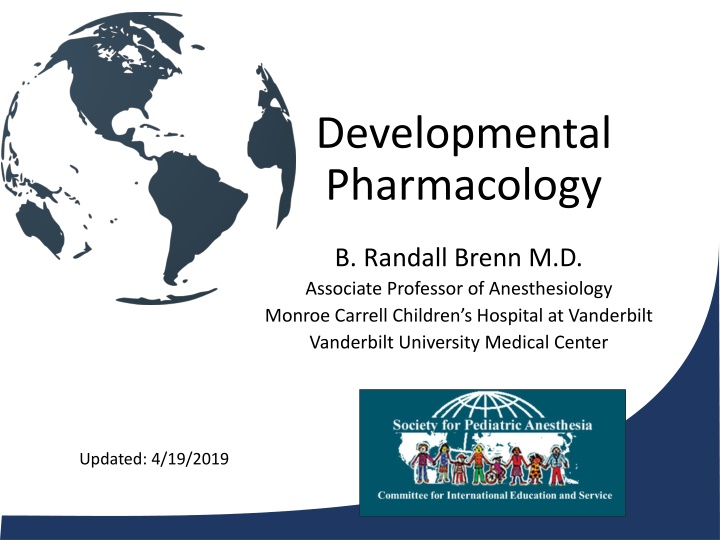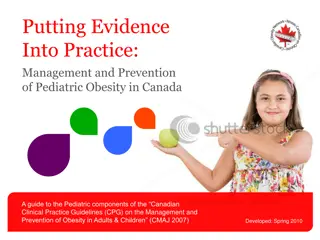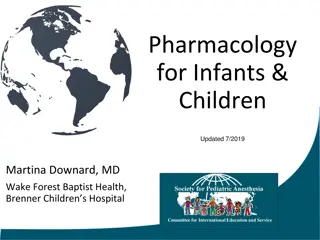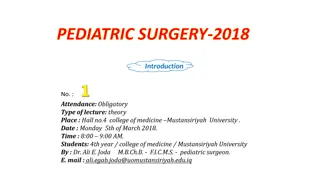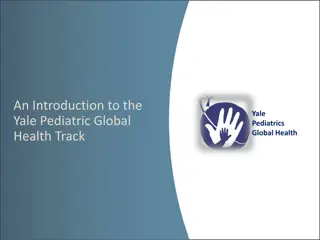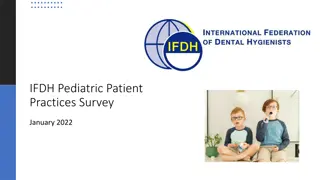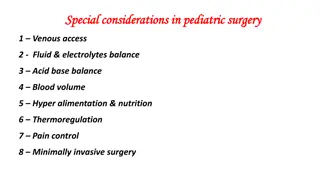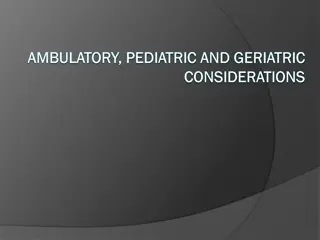Pediatric Pharmacology Considerations and Challenges
Developmental pharmacology in children involves unique considerations such as drug metabolism, urine concentration, and muscle relaxant dosing. The field faces challenges with limited drug testing in pediatric populations, emphasizing the importance of age-appropriate pharmacotherapy. Factors like drug distribution, body composition changes, and volume of distribution impact pediatric drug dosing. Understanding these nuances is crucial for safe and effective medication use in children.
Uploaded on Sep 29, 2024 | 1 Views
Download Presentation

Please find below an Image/Link to download the presentation.
The content on the website is provided AS IS for your information and personal use only. It may not be sold, licensed, or shared on other websites without obtaining consent from the author.If you encounter any issues during the download, it is possible that the publisher has removed the file from their server.
You are allowed to download the files provided on this website for personal or commercial use, subject to the condition that they are used lawfully. All files are the property of their respective owners.
The content on the website is provided AS IS for your information and personal use only. It may not be sold, licensed, or shared on other websites without obtaining consent from the author.
E N D
Presentation Transcript
Developmental Pharmacology B. Randall Brenn M.D. Associate Professor of Anesthesiology Monroe Carrell Children s Hospital at Vanderbilt Vanderbilt University Medical Center Updated: 4/19/2019
Lets start with a few questions? When can an infant metabolize morphine? When can an infant metabolize propofol? When can an infant concentrate their urine? Why do we dose muscle relaxants in infants like adult patients? What age has the highest MAC? The lowest?
Dr. Abraham Jacobi (1830-1919) Children are not miniature men and women, with reduced drug doses and the same class of disease in a smaller body Age appropriate pharmacotherapy is important
Consider this The majority of medications used in children have not been tested in children Of 140 drugs used routinely in children, only 38% are labeled for use in children 90% of PICU drugs are used for purposes other than what they are approved for Tod, Fund Clin Pharm, 2008
Factors affecting drug distribution Volume of distribution Protein binding Metabolism Elimination
Changes in Body Composition Changes in body composition during growth Premature Infant (1.5 kg) Full-Term Infant (3.5 kg) Adult (70 kg) Body Compartment Total body water (% body weight) 83 73 60 Extracellular fluid (% body weight) 62 44 20 Blood volume (mL/kg) 60 85-105 70 Intracellular water (% body weight) 25 33 40 Muscle mass (% body weight) 15 20 50 Fat (% body weight) 3 12 18 From Cook DR, Marcy JH: Neonatal anesthesia, Pasadena, Calif, 1988, Appleton Davies.
Volume of distribution (Vd) Calculated value ECF is greatest at birth thus, water soluble drugs have greater Vd and lower concentration. A larger loading dose is thus required. Which drugs are water soluble?
Factors affecting drug distribution Protein binding in a neonate - Albumin binds acids and acid 1 glycoprotein binds bases - Both quantitative and qualitative immaturity - Local anesthetics may have larger free fraction of drug Metabolism is age dependent Elimination is usually faster in infants but may be slower in neonates.
Hepatic Function Transition at birth: Umbilical arteries form a part of the internal iliac arteries Ductus venosus atrophies and forms ligamentum venosum Now blood actually goes to the liver and not past it.
Hepatic Function Hepatic drug clearance determined by Liver blood flow Intrinsic clearance (bio-transformation) Plasma protein binding Extraction ratio High ratio, depends on blood flow Low ratio, intrinsic clearance (metabolism)
Hepatic Reactions Phase I reactions Reactions available in endoplasmic reticulum of liver, kidney, lung and GI tract Hydrolysis is present from birth. Water breaks up molecules Ester local anesthetics, succinylcholine Oxidation and reduction are not developed until 2 weeks of age Enzymes help move electrons around Pentothal, amide local anesthetics
Hepatic Reactions Phase II reactions Cytochrome p450 (among other enzyme systems) What is conjugation? Conjugation level is about 50% by 3 months of age; reaches 100% by 5 years of age. Glucuronide Morphine, Fentanyl, Propofol Sulfate - Acetaminophen When can an infant metabolize morphine?
Hepatic Enzyme Development Lu et al JPPT 2014
Hepatic Function Consider a 4 month old, ex 28 week infant versus a 1 week old, term infant Who can metabolize morphine? Postnatal age more important than gestational age
What drugs are affected? Atracurium/Cisatracurim - Ester hydrolysis Local Anesthetics - Amides-hepatic, then 10% renal excretion - Esters-hydrolysis then liver then renal excretion. Morphine - Glucuronidation-some active metabolites Propofol - Highly protein bound - Glucuronidation-liver and extrahepatic (lungs, kidneys?)
Renal Function Kidney is the most important organ for water soluble drug elimination. Nephrogenesis starts at 5-9 weeks and is complete by 36 weeks gestational age GFR and tubular function nearly mature by 5-6 months and fully mature at 2 years of age
Renal Function Creatinine measurements - Reflect maternal levels - Change in the first days to weeks Glomerular filtration rate - Low in the newborn - Increases sharply in first two weeks of life - Reaches adult levels by 1-2 years of age
GFR as a Function of Age Lu et al JPPT 2014
Renal Function Urine concentrating ability -Neonate 600 milliosmoles/L -Adult 1,200 milliosmoles/L The neonate with concentrated urine is probably very dehydrated
Specific Anesthetic Drugs Vecuronium Pancuronium Rocuronium Propofol Thiopental Midazolam Fentanyl Morphine
Vecuronium ED 95 -Infant: 47-60 mcg/kg -Child: 81-100 mcg/kg -Adult: 43 mcg/kg Duration -Infant: T1/2 beta 64.7 min -Child: T1/2 beta 41 min -Adult: T1/2 beta 32 min
Rocuronium ED 95 -Infant: 250-300 mcg/kg -Child: 400-450 mcg/kg -Adult: 350 mcg/kg Duration of action is longer in infants than in children and adults -Infant: 50% recovery in 60 min -Child: 50% recovery in 30 min
Pancuronium Long acting non-depolarizing muscle relaxant Older children need a larger dose than infants and small children Age ED50 (mcg/kg) 24 7 ED95 (mcg/kg) 45 7 3-6 months 7-12 months 30 5 52 9 1-3 years 34 9 62 18 4-6 years 29 8 62 13
Propofol Alkylphenol - Large volume of distribution - Slow elimination half-life - Rapid clearance via glucuronidation in liver and extra-hepatic sites Comparative metabolism: Clearance - Infant: 77 ml/kg/min - Child: 34 ml/kg/min
Thiopental Ultra-short acting barbiturate Induction doses (ED50) vary with age - Neonates = 3.5 mg/kg - Infants (1-6 months) = 7 mg/kg - Children (4-7 years) = 5 mg/kg - Adults = 4 mg/kg Clearance (T1/2) is slower in younger patients - Neonates: 6.1 ml/kg/min - Infants : 6.6 ml/kg/min - Adults: 12 ml/kg/min
Midazolam Water soluble 95% protein binding Hepatic CYP3A4 dependent Metabolized to 5,7-hydroxy midazolam Neonates Children Clearance (ml/kg/min) 1.8 9.1 T1/2 (minutes) 540 70
Fentanyl Dealkylation, hydroxylation, hydrolysis High hepatic extraction ratio Comparative Metabolism - Neonatal clearance comparable with older children and adult (significantly less in premature infants) - Clearance is gestational age and body weight dependent
Morphine Low hepatic extraction Metabolism via Glucuronidation M3 and M6 Comparative Metabolism Neonate Child Adult Protein Binding 18-22% 30-50% Vol Distribution 2.7 L/kg 1.13 L/kg Clearance 3.6 ml/kg/min 6.2 ml/kg/min T1/2 534 min 183 min
Inhalational Agents Is the induction of an infant faster or slower than that of an adult? Why would that be? What factors affect the uptake of inhalational agents?
Inhalational Agents Factors involved with uptake of agent Alveolar ventilation Inspired concentration Functional Residual Capacity Cardiac output Blood-Gas solubility Tissue-Blood solubility
Inhalation Agents in Infants Infant uptake compared to Adults Alveolar Ventilation Higher Inspired Concentration Same Functional Residual Capacity Same Cardiac Output Higher Blood-Gas Solubility Lower Tissue-Blood Solubility Lower
Factors Explaining Wash In Neonates have a higher ventilation to FRC ratio (5:1 vs 1.5:1) compared to adults Inhalational agents are less soluble in the blood of neonates than older children and adults Inhalational agents are less soluble in the tissues in neonates A higher percentage of cardiac output in neonates goes to the vessel rich groups (to the brain)
Minimum Alveolar Concentration Definition of MAC Minimum concentration of vapor in the lungs that achieves anesthesia in 50% of subjects MAC is age dependent Let me show you
Questions What age has the highest MAC? The lowest? When can an infant metabolize morphine? When can an infant metabolize propofol? When can an infant concentrate urine? Why do we dose muscle relaxants like adult patients?
